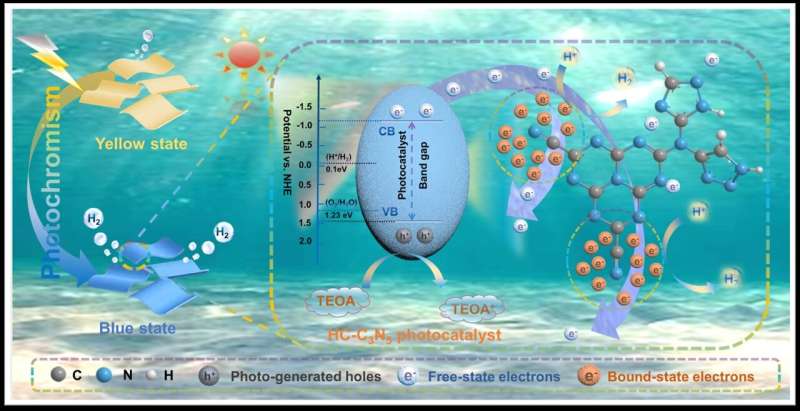This article has been reviewed according to Science X's editorial process and policies. Editors have highlighted the following attributes while ensuring the content's credibility:
fact-checked
proofread
Study reveals insights into the establishment of bound electronic states for developing efficient photocatalysts

Photocatalytic water splitting, a sustainable energy strategy, utilizes solar energy to produce clean hydrogen fuel. While it offers a promising solution to the global energy crisis and environmental pollution, the slow kinetics of photogenerated electron-hole pairs result in low activity for most semiconductor materials, even with sacrificial agents. To that end, integrating electron traps and reactive centers could be a feasible strategy to enhance charge separation and catalytic performance.
In a new study, researchers at Jiangsu University of Science and Technology and Zhejiang Ocean University synthesized high-crystallinity nitrogen-rich carbon nitride nanosheet photocatalysts via an alkali potassium salt-assisted molten salt method, promoting photocatalytic hydrogen evolution. The researchers published their findings in Advanced Powder Materials.
"We elucidated the role of bound-state electrons in broadening the absorption spectrum and generating photogenerated charges and verified the electron migration pathway induced by cyanide groups, coordinating the transition of photoexcited electrons from an unbound to a bound state," says co-corresponding author Shijie Li.
The team synthesized the exceptional performance of highly crystalline C3N5 (HC–C3N5) nanosheet as a photocatalyst, demonstrating a hydrogen evolution rate of 3.01 mmol h−1 g−1, which surpasses that of bulk C3N5 (B– C3N5) by a factor of 3.27.
"Experimental and theoretical analyses reveal that HC-C3N5 nanosheets exhibit macroscopic photoinduced color changes, effectively broadening the absorption spectrum and significantly enhancing the generation of excitons," explains Weilong Shi.
Notably, the team discovered potential electron capture sites, which contributed to understanding complex reaction kinetics, strengthening charge separation dynamics during photocatalytic hydrogen production.
More information: Yu Shen et al, Bound-state electrons synergy over photochromic high-crystalline C3N5 nanosheets in enhancing charge separation for photocatalytic H2 production, Advanced Powder Materials (2024). DOI: 10.1016/j.apmate.2024.100202
Provided by KeAi Communications Co.




















